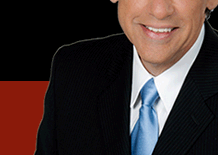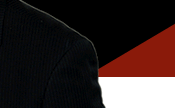
|
| From
the Field |
|
|
 The
Beginning, and the End? The
Beginning, and the End?
By Mitch Waldow
Channel 13 went on the air as KLAC-TV on September 17, 1948.
The first program: a live telecast of a college football game,
USC against Utah State at the L.A. Coliseum.
Unfortunately, viewers saw mostly snow until halftime, when
technicians managed to get the signal cleaned up. Forty years
later, the station would be broadcasting the L.A. Marathon --
a 24 camera shoot that's arguably the most technically complex
local sport telecast in the country.
Dorothy Schiff, who owned the New York Post, was the original
owner of KLAC Radio and TV. She got the license in 1946, and
took over the old KMTR hacienda-style studios in Hollywood,
built on land once occupied by Buster Keaton's studio, and before
that, Charlie Chaplin's Lone Star studio. Schiff changed the
call letters to KLAC, for Los Angeles California, and brought
Don Fedderson down from San Francisco to get the tv station
on the air. Fedderson later would become the producer of "My
Three Sons," "Family Affair" and other landmark shows. He assembled
an incredibly talented staff of engineers and personalities
who helped put Channel 13 on the map with a mix of sports and
live entertainment.
Some of the engineering folks came from Warner Bros., an early
investor in the station which tried, unsuccessfully, to buy
it a couple of years later.
In the days before the coaxial cable connected the networks
to both coasts, television in Los Angeles meant LOCAL programs.
Network shows were provided on film on a delayed basis. Many
stars of early network television started out in L.A., and many
of them started at Channel 13.
Among those who got their starts at 13 is Betty White, who was
a "girl Friday" on the Al Jarvis "Hollywood on Television" show.
She then hosted a six hour daily chat show with show biz veteran
Eddie Albert. Later, Betty added a live Saturday night sitcom,
"Life with Elizabeth," to her weekly schedule.
General Manager Fedderson discovered pianist Liberace at a nightclub
and brought him and his candelabra to the station, and he was
an immediate hit.
Nightclub artists Bobby Short and Hadda Brooks had shows of
their own -- among the first African-Americans to appear on
the small screen. Country star Tennessee Ernie Ford was a regular
on Cliffie Stone's "Hometown Jamboree," which aired on Saturday
nights.Behind the scenes, future director Sam Peckinpah served
the station as a grip, and shot his college thesis at the station
after hours. Actor Leonard Nimoy also moved props at Channel
13. And Regis Philbin was a newswriter.
In 1954, the station was bought by a San Diego-based newspaper
chain, The Copley Press. The station's call was changed to KCOP.
By then, the major networks were beginning to flex their muscles,
and live local shows -- especially the big ones out of ballrooms
and auditoriums -- were scaled back. A new programming genre
was created: the travelogue. And KCOP had one of the first,
"I Search for Adventure," hosted by Jack Douglas. Each week,
Douglas would bring a real explorer or adventurer to the studio,
who would narrate their film. KCOP soon came to dominate the
L.A. market in travelogue programming.
One producer, Bill Burrud, hosted as many as four different
travel shows a week on KCOP. In 1956, a group of investors headed
by Bing Crosby, purchased the station. Crosby had a financial
interest in Ampex, and in 1957 KCOP took delivery of two of
the first videotape machines in the country.
In 1960, Chris Craft Industries, a newly-formed conglomerate
which included a plastics fabrication company and the boat building
concern, added KCOP to its fledgling tv station group.
Over the years, KCOP continued to offer innovative programming,
especially in the area of childrens shows. In fact, through
the 1980s, KCOP led the market in kids' programming.
By the 1970s, it was clear that independent television stations
faced tough network competition. The typical fare of older syndicated
programming couldn't stand up against first run network shows.
In a bold move, Chris Craft formed a partnership with several
major Hollywood studios to co-produce first run programming.
The mini-series, "A Woman Called Golda," starring Ingrid Bergman,
was one of the first efforts, and a very successful one. Another
bold idea was to run controversial films like "The Deer Hunter"
uncut.
And in the 90s, parent company United Television and Paramount
formed UPN, and brought new generations of Star Trek, among
other programs, to KCOP.
And there's the L.A. Marathon. The station had been trying to
win broadcast rights for a pro ball team but kept getting shut
out. At first, nobody wanted the Marathon, but it proved a bonanza
for KCOP, and it soon became the station's signature event.
KCOP even had a couple of good seasons with the Clippers. Well,
maybe one good season.
The station also made its mark and won many awards for its yearly
"Live from the Hollywood Bowl" specials, and also broadcasts
the Hollywood Christmas Parade. KCOP's news operation was described
by a local paper as "scrappy." The news department had more
guts and gall than it had gear. But somehow over the years KCOP
has managed to collect its fair share of broadcast journalism
awards, culminating with the L.A. area Emmy for best newscast
over 35 minutes. And now another chapter opens for Channel 13.
And how's this for a coincidence. Parent company News Corp.
owns the New York Post -- the same paper once run by Channel
13's first owner, Dorothy Schiff. Full circle.
About the Author
Mitch Waldow is an award-winning broadcaster who's worked in
Los Angeles radio and television from more than 25 years. He's
KCOP's Archive Manager and occasional specials producer. |
|
|
|
| |
|

















